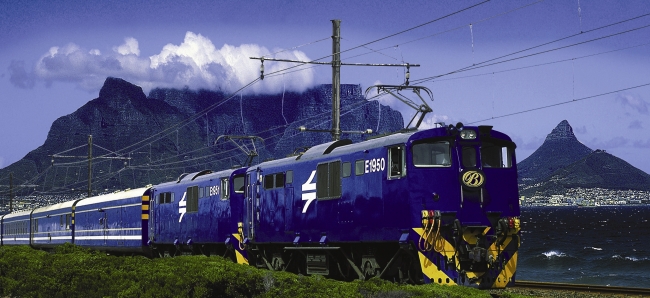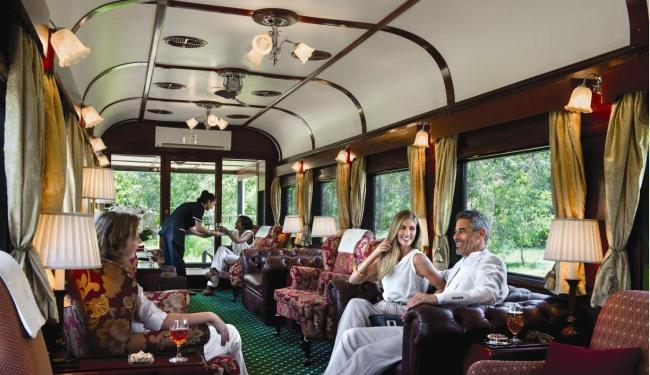Saturday, June 15, 2013
0617-Wining and dining on the African railway
The landscape transformed utterly as we neared Cape Town. Mountainous scrubland that could have been plucked from a Hollywood western gave way to the vineyards of Hex River Valley, the source of 20 percent of South Africa’s wine production.
Copper peaks, ringed by low-hanging clouds, soared above endless vineyards turned red and gold by the South African autumn. Inside our dining car, we drank the fruits of the region, a dry Thelema Riesling, recommended by our waiter to accompany our Sunday lunch. As this spectacular scene passed by, we dined on traditional South African Bobotie, a dish of spiced ground beef with a beaten egg topping, grilled prawn skewers, Drunken Pecornio cheese; and melkart, a local milk-based tart.
On Friday we had began the 1,600 km journey from Pretoria to Cape Town with Rovos Rail, self-described as the “world’s most luxurious train.”
South Africa, with its vast cinematic landscape, holds special appeal for the unhurried traveler who appreciates a journey for a journey’s sake, and experienced in the utmost comfort. The history of luxury rail travel in South Africa is accordingly rich. The first steam engine in the country ran in 1860, but it was with the discovery of gold and diamonds near the end of the 19th century that rail exploded as a means of transport. Reflecting this new wealth, the Union Express and Union Limited, featuring comforts like hot water on tap and, later, air-conditioning, debuted in the early 1920s. From these trains evolved the Blue Train, first christened in 1946, which also travels the Pretoria-Cape Town route.
From our first impressions, it was clear that Rovos did not make lightly its claim to being unmatched for luxury travel. The railway company, the baby of entrepreneur Rohan Vos, has operated beautifully restored steam engines and carriages from the earlier part of the 20th century on routes across South Africa and neighboring countries since 1989. The Pretoria-Cape Town route takes 48 hours, mostly due to a number of extended stops and train’s leisurely maximum clip of 60km/h. Rovos is not concerned with speed, but transporting to a different era a generation that has “lost the art of travel.”
“In our grandfather’s day... it was not about the destination as it is now,” sales manager Edward Mitchell told us before departure on a tour of the company’s rail yard and workshop.
Travelers on Rovos will likely come to appreciate this sentiment. Each passenger is assigned a personal butler, on call 24/7 to attend to their every whim. There are three types of suite to choose from, the most luxurious of which, the Royal suite, even comes with a bath tub.
Rovos builds all its interiors and furniture itself, and this shines through in the décor throughout. Our Deluxe suite was elegantly furnished and surprisingly spacious, including a generous bed, desk, shower and even mini bar, which is stocked as you please for no extra charge.
Passengers will also dine well, with breakfast, lunch, high tea and dinner served throughout. A gong at mealtime was our signal to make our way to the dining car. All of the food served to us ranged from good to exceptional. Yelvety soft scallops with a lemon-infused hollandaise sauce, braised lamb and a decadently rich chocolate fondant, in particular, were exceptional.
Having taken Rovos to Cape Town, we returned to Pretoria by the Blue Train, so called because of the color of the engine and carriages. With a history of transporting kings and presidents, this is a train that prides itself as an institution. Numerous details, from the “B” logo on the pen at your cabin’s writing desk to the chocolates on your pillow, stamp the Blue Train identity throughout the train.
Where Rovos journeys back in time, the Blue Train is a more modern affair, while retaining a strong sense of nostalgia. The ride as we zipped along at a relatively brisk 90 km/h was nothing but smooth. The greater top speed and fewer stops allow the Blue Train do the cross-country route in 24 hours, every minute of which you can expect to be pampered. We found the staff always on hand to refill our wine glass the moment it had been drained and the quality of the meals excellent. Dinner’s Beef Wellington, pink, moist and perfectly paired with a rich red wine sauce, was among the best fillet I have had.
Although a world away from their country, Korean travelers may even discover reminders of home onboard.
“Of late we are seeing quite a lot of the Koreans,” said train manager Philani Ndlela. “We are encouraging our staff members to learn different languages because of our clientele base we have on the Blue Train. For starters, some of them (are doing) Japanese lessons, we are going to do Chinese, next Portuguese and then Korean. This will enable us, as much as they won’t be 100 percent fluent, to grasp the basics to accommodate them. There’s nothing as wonderful to find that, ‘wow, I am on the Blue Train and they can understand exactly want I want.’”
While the joy is in the journey, both trains make extended stops at sights along the way. Whether leaving Pretoria or Cape Town, Rovos calls in at the old diamond-mining town of Kimberly, where passengers are introduced to the Big Hole, a depleted diamond mine. Dug more than 700 feet into the earth by hand, the hole is carpeted in a turquoise body of water the size of eight football fields. Next stop is Matjiesfontein, a quaint village a few hours outside Cape Town that appears to be stuck in a Victorian time wrap.
Those taking the Blue Train going north will be treated to a bizarre but entertaining tour of Matjiesfontein (the train going south stops instead at Kimberly). Moving at a crawl in a dilapidated London double-decker, we were led by eccentric tour guide John Theunissen on what we were assured was “the shortest tour in Africa,” accompanied by humorously Vincent Price-like narration. Afterward, we savored a brandy at the village bar, where our tour guide became full blown entertainer, hammering out rail-road era folk standards on a piano in the corner.
Back on broad, there was nothing more enjoyable than to watch the African plains zip by, a stiff drink in hand, and the frenzy of Seoul half a world away. Few other journeys could leave one so sad to reach your destination.
By John Power

